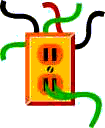Thales of Miletos: Way back in 600 BC, Thales was polishing amber which is a fossilized resin. He was using a piece of wool or fur. After rubbing the amber, either straw or feathers stuck to the amber. He realized that by rubbing the amber he had created a static electric charge. He had produced static electricity.
William Gilbert: In the 1600's, Gilbert continued to experiment with amber and magnets. He wrote a report on the theory of magnetism. He invented a tool that looked like a compass but without the magnetized needle. In side was a needle that moved because of a reaction to a magnet. This invention called a versorium, today with some changes it is called an electroscope. It was Gilbert who first used the term electricity. For the next 350 years there were many investigations and experiments carried out because of the work of Gilbert.
Otto Von Guericke: In 1660, he built the first electric generating machine. Von Guericke showed that electricity could be transmitted (transferred from place to place).
Stephen Gray: It was almost 70 years later when Gray, through experimenting, found out that electricity could be transferred by using wire.
Ben Franklin: Shortly after that, in 1752, Franklin completed his famous experiment. He flew a kite with a wire pointing up that was attached to the top of the kite. At the end of the kite string, he attached a metal (iron) key. Needless to say, the wire sticking up from the kite acted like a lightning rod and when he flew the kite in a thunderstorm, the lightning struck the kite, travelled down the string to the metal key. Not only did he prove that lightning and the spark from amber were the same thing but he also invented the lightning rod.
James Watt: In the mid 1700's Watt, the inventor of the steam engine, worked at improving his engine. The electric unit of power, the Watt, was named after James Watt.
Luigi Galvani: While experiments with frogs legs, Galvani found that when he touched the leg with a metal knife, the leg muscles began to twitch. He thought that frog muscles must contain electricity.
Alessandro Volta: He took Galvani's experiment further and realized that the muscles didn't have electricity, the electricity was produced because there were 2 metals ( the knife and the plate the frog was on ) and there was moisture in the frog legs. The moisture and the 2 different metals produced the electricity. Volta invented the first electric battery and found out that electricity could flow continually from one place to another through a wire. The term VOLT was named after Volta.
Michael Faraday: Faraday, in the 1830's conducted experiments on electricity and magnetism. He developed a way to generate a lot of electricity at once. He also worked on the idea that if electricity could produce magnetism then magnetism should be able to produce electricity. He experimented using copper wire and magnets and found out that when a magnet was moved inside a coil of copper wire then an electric current would flow through the wire. It was Faraday's work that eventually led to inventions such as such as the generator, motor, telegraph, transformer and telephone.
Andre Ampere and Georg Ohm: Ampere studied electricity and magnetism (electromagnetism) and his name is used as a unit of electric current. Ohm looked at relationships between volts and currents and came up with a law called Ohm's Law. His name is also used as a unit.
Thomas Edison: In the late 1800's Edison investigated and experimented with DC current (direct current). He is best known for his invention of incandescent light bulb. Under his direction, the first electric generating station was built in New York City and it provided electricity to one square mile.
Nikola Tesla: Tesla developed a motor that generated AC current. The use of alternating current would allow for a higher voltage of power to be used as well as transformers. It proved to be the way to go.

